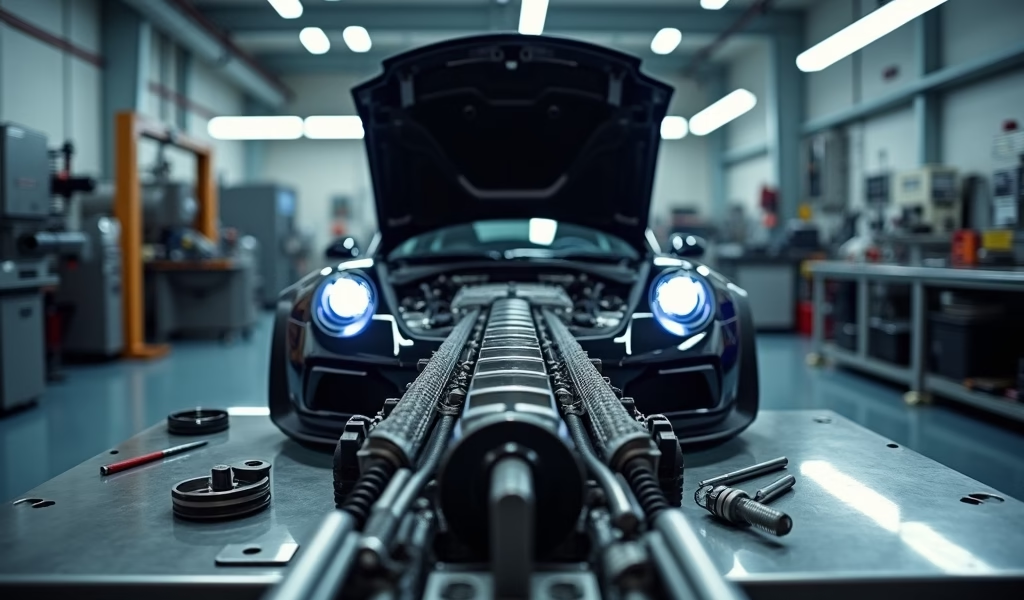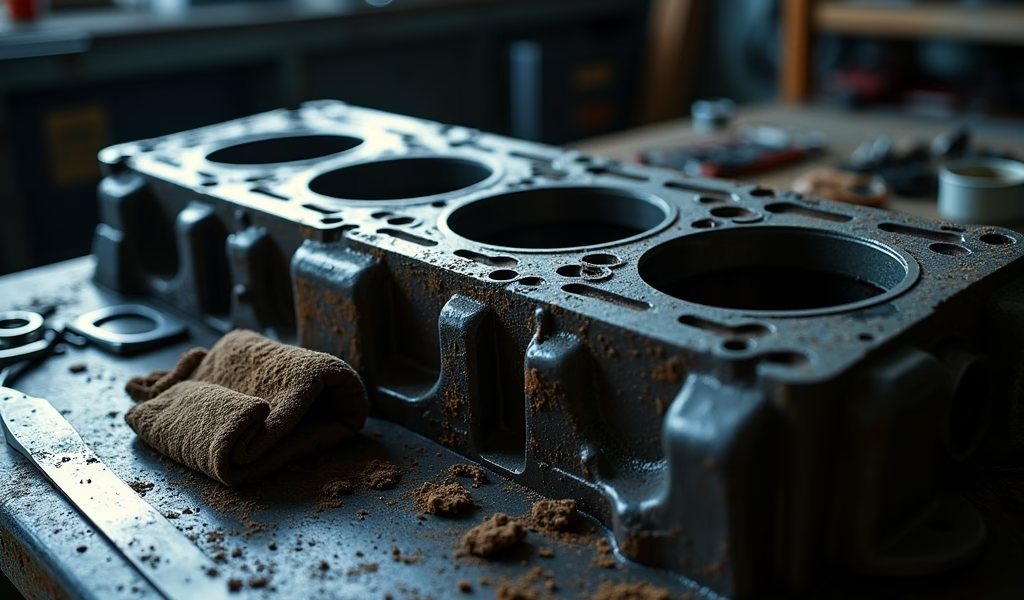Overview
This guide explains five solutions for repairing engine block deck surface problems, ranging from professional machining to complete block replacement, with costs typically between $150-$4,500+ depending on severity. Proper maintenance, including correct head bolt torquing and cooling system care, can prevent these issues that manifest through symptoms like white exhaust smoke, coolant loss, and decreased engine performance.
Table of Contents
- Understanding Engine Block Deck Surface
- Common Symptoms of Deck Surface Problems
- Fix #1: Professional Deck Surface Machining
- Fix #2: Deck Plate Installation
- Fix #3: Composite Deck Repair
- Fix #4: Thread Repair and Surface Restoration
- Fix #5: Complete Block Replacement
- Preventing Deck Surface Issues
- Conclusion
- Frequently Asked Questions
Understanding Engine Block Deck Surface
The engine block deck surface is the flat top portion of your engine block where the cylinder head sits. Think of it as the foundation of your engine’s power system. When this surface isn’t perfectly flat, it’s like trying to seal a container with a warped lid – it just won’t work properly.
In my 20+ years as a mechanic, I’ve seen countless engines suffer from poor performance due to compromised deck surfaces. This critical component must maintain absolute flatness to create a proper seal with the head gasket and cylinder head.
The deck surface’s integrity directly impacts compression, prevents coolant and oil leaks, and ensures your engine delivers the power you expect when you press the gas pedal. When problems develop here, they typically cascade into more serious issues if not addressed promptly.
Common Symptoms of Deck Surface Problems
Your engine can’t talk, but it certainly communicates when something’s wrong with the deck surface. Here are the telltale signs I’ve encountered in the shop:
- White or blue-tinted exhaust smoke, especially during startup
- Mysterious coolant loss without visible external leaks
- Gradually decreasing engine performance and power
- Persistent overheating issues, particularly under load
- Oil and coolant mixing (that dreaded milky substance in your oil)
- Compression test showing low or uneven readings across cylinders
- Bubbling in the radiator or coolant reservoir
The most common causes of deck surface issues include engine overheating, improper head bolt torquing, age-related deterioration, poor previous repairs, and coolant chemistry problems that lead to corrosion.

Fix #1: Professional Deck Surface Machining
Professional machining (often called resurfacing or “decking”) is the gold standard for addressing most deck surface issues. In my experience, this is the most reliable first approach for engines with warpage or minor surface imperfections.
The Machining Process
When you bring your engine to a machine shop like mine, we follow a precise process:
- Thoroughly clean the block to remove all debris and oil residue
- Measure the existing surface with precision tools (often to 0.0001″ accuracy)
- Mount the block securely on specialized equipment
- Mill or grind the surface to achieve perfect flatness
- Verify measurements meet manufacturer specifications
- Clean and prepare the surface for reassembly
The goal is to remove the minimum amount of material necessary to restore flatness. This preserves the original block height as much as possible, which maintains proper compression ratios and valve timing.
For most passenger vehicles, professional resurfacing costs between $150-$300, though this varies by location and engine complexity. Considering the alternative—continued performance issues or even complete engine failure—this is an investment that typically pays for itself many times over.
I’ve seen properly resurfaced blocks run for another 100,000+ miles without issues. The key is catching the problem before it leads to major component failures requiring more extensive repairs.
Fix #2: Deck Plate Installation
For engines that have experienced severe deck surface issues or those being built for high-performance applications, deck plates provide an excellent solution. These reinforcement plates distribute head bolt clamping forces more evenly across the deck surface.
When To Consider Deck Plates
In my shop, I recommend deck plates for:
- Performance engines that experience extreme heat cycling
- Blocks that have been overbored or have thin cylinder walls
- Applications where maximum sealing is critical
- Engines that have experienced previous deck warping issues
Think of deck plates as insurance against future problems. They’re particularly valuable in racing applications where engine reliability under extreme conditions is essential.
Installation Process and Costs
Installing deck plates isn’t a DIY job. The process requires:
- Professional machining of the deck surface first
- Selecting the appropriate deck plate material (typically steel or aluminum)
- Precise drilling and tapping for mounting points
- Installing plates with specialized fasteners and torque specifications
- Final machining of the combined surface for perfect flatness
This solution typically costs $500-$1,000 depending on your engine type and the material selected. While more expensive than simple resurfacing, it provides significant insurance against future issues for high-stress engines.
According to Engine Builder Magazine, deck plates can improve cylinder bore geometry by up to 0.002″ in some applications, which is significant for high-performance engines.
Fix #3: Composite Deck Repair
When your deck surface has cracks or severe pitting that can’t be addressed by simple resurfacing, composite repairs offer an excellent middle-ground solution. I’ve saved many customers the cost of a new block using these advanced repair techniques.
The Modern Repair Process
Today’s composite repairs use specialized epoxy-based compounds that are specifically engineered for engine block repairs. These aren’t your hardware store epoxies—they’re industrial-grade compounds designed to withstand extreme heat, pressure, and chemical exposure.
A proper composite repair follows these steps:
- Thorough cleaning and degreasing of the damaged area
- Creating mechanical “keys” where the composite material can bond
- Applying specialized high-temperature epoxy compounds
- Controlled curing, often with precise heat application
- Precision machining the repaired surface for flatness
- Testing for integrity under pressure
Real-World Performance
In my experience, properly performed composite repairs can provide 80-90% of the strength of the original material. I’ve repaired blocks that have gone on to deliver tens of thousands of trouble-free miles.
These repairs are particularly valuable for:
- Vintage or rare engines where replacement blocks are unavailable
- Localized damage that doesn’t compromise the entire block
- Situations where budget constraints make block replacement impractical
- Emergency repairs when time is of the essence
Professional composite repairs typically cost between $300-$700 depending on the extent of damage. Diesel engine blocks with their higher pressures may require more extensive work and specialized materials.

Fix #4: Thread Repair and Surface Restoration
Sometimes the deck surface itself is in reasonable condition, but the head bolt holes that secure everything together have been stripped, corroded, or damaged. I’ve restored countless engines with this combination approach.
Thread Repair Options
Several proven thread repair systems are available, each with its own benefits:
- HeliCoil Inserts: Coiled stainless steel wire inserts that create new threads often stronger than the original. They’re relatively easy to install and provide excellent holding power.
- TimeSert: Solid bushing-type inserts that create a complete new threaded hole. These are more expensive but offer superior strength for critical applications.
- Big-Sert: Similar to TimeSerts but designed for severely damaged holes that require significant reinforcement.
In my shop, I prefer TimeSerts for head bolt repairs because they provide the most reliable long-term solution, especially in aluminum blocks where thread strength is critical.
The Restoration Process
A complete thread and surface restoration includes:
- Assessing all head bolt holes for damage (sometimes using specialized borescopes)
- Drilling out damaged threads to the specified oversize dimension
- Tapping and installing appropriate thread inserts
- Resurfacing the deck to ensure perfect flatness
- Cleaning and preparing all surfaces for reassembly
Thread repairs actually enhance deck integrity by creating stronger threads than the original material. This ensures proper torque retention and more even distribution of clamping forces.
Expect to pay $30-50 per hole for professional thread repair, plus the cost of any necessary resurfacing. For an average V8 engine needing all holes repaired, that’s about $300-500 for thread repair alone.
Researchers at SAE International have found that properly installed thread inserts can provide up to 125% of the original thread strength in aluminum components.
Fix #5: Complete Block Replacement
Sometimes, the most cost-effective solution is to replace the engine block entirely. In my decades of experience, I’ve learned to recognize when repair attempts would be throwing good money after bad.
When Replacement Makes Sense
Consider block replacement when:
- Multiple severe cracks are present throughout the block
- The block has been previously repaired multiple times
- Cylinder walls are damaged beyond reasonable repair limits
- The cost of comprehensive repairs exceeds 70% of replacement
- The engine has experienced catastrophic overheating that compromised metallurgical integrity
Sourcing Quality Replacement Blocks
When seeking a replacement block, I advise my customers to consider these options:
- Remanufactured blocks: These undergo thorough inspection, machining to specification, and updating with new components where necessary. They typically come with warranties ranging from 12 to 36 months.
- New OEM blocks: Available for some engine models, these provide peace of mind but at a premium price.
- Used blocks: The least expensive option but requiring careful inspection. I recommend pressure testing and magnaflux inspection before installation.
- Aftermarket performance blocks: Companies like Dart and World Products offer enhanced blocks with improved features for performance applications.
Cost Analysis
Let’s break down the typical costs I’ve seen:
- Extensive repairs on severely damaged block: $1,000-$2,000+
- Used replacement block (verified good condition): $500-$1,500
- Remanufactured block: $1,500-$3,000
- New OEM block: $2,500-$4,500+
While replacement seems expensive, it often makes more financial sense than attempting to repair a block with multiple severe issues. The diesel engine compression ratios and resulting pressures make this especially true for diesel applications.
Preventing Deck Surface Issues
An ounce of prevention is worth a pound of cure – especially when it comes to your engine block. Here are my top recommendations for preventing deck surface problems:
Proper Torquing Procedures
- Always use a calibrated torque wrench for head bolts
- Follow the manufacturer’s torque sequence exactly
- Implement the correct torque steps (often 30%, 60%, then 100%)
- Replace head bolts if recommended (many are stretch-designed for one-time use)
- Use the specified assembly lubricant on threads
I’ve seen countless engines damaged by improper torquing. This simple step is absolutely critical for long-term reliability.
Cooling System Maintenance
- Replace coolant at recommended intervals (typically every 2-5 years)
- Use the correct coolant type specified for your engine
- Ensure the cooling system maintains proper pressure
- Address overheating issues immediately – never “limp home” an overheated engine
- Consider installing an aftermarket temperature gauge for older vehicles
According to the National Highway Traffic Safety Administration, cooling system failure is a leading cause of mechanical breakdowns. Regular maintenance dramatically reduces this risk.
Warning Signs to Watch For
I always advise my customers to pay attention to these early warning signs:
- Rising coolant temperature during highway driving
- Unexplained coolant loss (even small amounts)
- White smoke from exhaust, especially at startup
- Bubbling in the radiator or overflow tank
- Sweet smell from the exhaust (indicates coolant burning)
Catching these symptoms early can be the difference between a minor repair and a complete engine rebuild. Don’t ignore what your engine is trying to tell you!
Conclusion
The engine block deck surface might not be a component you think about often, but its condition is absolutely critical to your engine’s performance, reliability, and longevity. After working on thousands of engines over my career, I’ve seen how this often-overlooked component can make or break an engine’s health.
Whether you’re facing warpage, cracks, or surface irregularities, there’s a solution that fits your specific situation and budget. From professional machining to complete replacement, the key is addressing problems promptly before they cascade into more serious and expensive issues.
Remember that proper maintenance—especially cooling system care and correct assembly procedures—can prevent many deck surface problems before they start. Pay attention to the warning signs your engine gives you, and don’t hesitate to have suspicious symptoms checked by a professional.
Your engine block deck surface is truly the foundation upon which your engine’s performance is built. Treat it with care, address issues promptly, and it will reward you with thousands of trouble-free miles.
Frequently Asked Questions
How much does it cost to resurface an engine block deck?
Professional engine block deck resurfacing typically costs between $150-$300 for most passenger vehicles. This cost varies based on engine size, location, and the extent of damage being corrected.
How do I know if my engine block deck surface needs repair?
Common symptoms include white exhaust smoke, unexplained coolant loss, decreasing engine performance, overheating issues, and oil/coolant mixing. A compression test showing low or uneven readings across cylinders is also a telltale sign.
Can a warped engine block be repaired?
Yes, most warped engine blocks can be repaired through professional machining to restore a flat surface. The success depends on the severity of the warp and whether it exceeds the manufacturer’s minimum deck height specification.
How long does engine block deck repair last?
A properly machined deck surface typically lasts for the remaining life of the engine when combined with correct assembly procedures. Most professional repairs should provide at least 100,000 miles of trouble-free operation.
Can I drive with a cracked engine block deck?
No, driving with a cracked engine block deck is not recommended as it can lead to coolant loss, overheating, and catastrophic engine failure. Address this issue immediately to prevent further damage and potential safety hazards.


Pingback: Main Bearing Cap Torque Sequence: 5 Tips - knowsyourcar.com
Pingback: Crankshaft End Play Measurement: 7 Tips - knowsyourcar.com